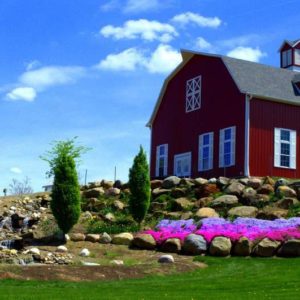Tom Dayton, Mr. Sustainability
Tom Dayton’s idea to capture all the rainwater that fell onto his greenhouse/nursery property and recycle/reuse it on the same property was just the first step in a long line of conservation projects he has implemented over the past 18 years. Once the water system was in place, Tom moved toward developing the botanical garden that would be used for environmental research of weather and plant viability. About the same time the garden was planted, the Owl Barn was built, proudly displaying a “green roof”. Now, Tom didn’t stop with the Owl Barn porch roof. Last year, the first phase of solar panels were installed on the main store roof, which will help reduce the amount of energy used from fossil fuels. This year, Dayton’s took a brand new approach to pest control. They are using “good” bugs to fight the bad bugs! The term sustainability wasn’t even coined when Tom formed his conservation vision, however, that’s exactly what he has been doing – moving his operation toward sustainability.
to capture all the rainwater that fell onto his greenhouse/nursery property and recycle/reuse it on the same property was just the first step in a long line of conservation projects he has implemented over the past 18 years. Once the water system was in place, Tom moved toward developing the botanical garden that would be used for environmental research of weather and plant viability. About the same time the garden was planted, the Owl Barn was built, proudly displaying a “green roof”. Now, Tom didn’t stop with the Owl Barn porch roof. Last year, the first phase of solar panels were installed on the main store roof, which will help reduce the amount of energy used from fossil fuels. This year, Dayton’s took a brand new approach to pest control. They are using “good” bugs to fight the bad bugs! The term sustainability wasn’t even coined when Tom formed his conservation vision, however, that’s exactly what he has been doing – moving his operation toward sustainability.
A greenhouse/nursery business needs LOTS of water, about 100,000 gallons per day on a hot day in August. In 1999, Tom Dayton decided to catch all the rainwater off the roofs of the buildings, parking lot and land to recycle for two reasons; to give a fresh source of rainwater to the plants and become environmentally friendly. Did you know that one inch of rainwater equals six inches of water in the irrigation lake? Dayton’s closed water system catches everything – no water leaves his property, this ensures that no impurities like fertilizer or pesticides have the possibility of getting into drinking water, downstream. The water system is a “win-win”; a win for Dayton’s that gives them water for their plants and a win for the environment – it just makes good business sense.
The Wolf Creek Botanical Garden, installation that began in 2002, has a very diverse topography; steep slope, bog gardens, shade gardens, formal gardens, naturalized gardens, and a J apanese garden. Tom’s vision was to make a place for environmental research of weather and plant viability in our plant zone, as well as to inspire and excite visitors for ornamental purposes. The garden teaches visitors to modify one’s environment, i.e. visual and/or sound barriers, wind screens, use of trees for cooling, as well as attraction of birds and wildlife. The Wolf Creek Botanical Garden is ever changing and worth an annual visit to enjoy the beauty and garner a little environmental education.
apanese garden. Tom’s vision was to make a place for environmental research of weather and plant viability in our plant zone, as well as to inspire and excite visitors for ornamental purposes. The garden teaches visitors to modify one’s environment, i.e. visual and/or sound barriers, wind screens, use of trees for cooling, as well as attraction of birds and wildlife. The Wolf Creek Botanical Garden is ever changing and worth an annual visit to enjoy the beauty and garner a little environmental education.
The construction of the Owl Barn’s porch gave Tom the opportunity to display and educate on the positive effects of a “green roof”. A green roof will reduce the water runoff as it will absorb the water and release it slowly through evaporation. The inside of the building will remain much cooler due to the evaporation of the water from the plants and the absence of a baking hot surface. Tom’s green roof, made of pots that display the “coats of many colors”, retains rainwater, moderates the water temperature and acts as a natural filter for any of the water that happens to runoff. The larger area of the Owl Barn roof does not have a green roof due to the steepness, however, the entire runoff from rainfall is captured to help supply the irrigation lake for the daily watering in the greenhouse/nursery.
The fall of 2016 brought about the first phase of Tom’s goal to reduce the use of energy from fossil fuels. Solar panels were installed on the west sloping roof and the south sloping roof of the main store building. The panels will collect a capacity of 21 KW on sunny days mid spring through fall and will send power into the electric grid. Late fall through early spring power will be used from the grid, although the solar panels will still generate some power. This will equal a net zero use of electricity on one of the two electric meters on the store building. Over the next four years, more panels will be added to achieve a net zero use of electricity from ALL electric meters equaling a reduction of energy from fossil fuels.
Today, more and more greenhouse growers and possibly farms are using beneficial predators, lessening the use of pesticides, and Tom implemented this concept in his greenhouses this spring. He applied the microscopic worms called nematodes. These small creatures move in water so that the foliage of the plants must be kept wet for no less than 2 hours so they are able to hunt down and kill the destructive thrip insect. A plus in their use is that there are no restrictions by EPA as far as entry into the greenhouse once the nematodes are applied, as they already exist in nature and are completely harmless to humans. When the hanging baskets are hung up, two small packets of predatory mites will be attached to the plant’s foliage. These packets called mini-sachets contain two mite species named Amblyseius californicus and Amblyseius curcurbitae. The californicus mite seeks out the nasty European two spotted spider mite while curcurbitae prefers the lousy thrip insect. Everyday several of the mites walk out of a hole in the sachet for a total of 6 weeks which will protect the plant from destructive greenhouse pests without chemicals! Tom was excited to be using “good bugs to fight bad bugs” this spring.
Tom Dayton may have begun his walk down the road to sustainability for Dayton’s Nurseries in Norton, Ohio way back in 1999, but he is the first to say, “we’re not finished yet!”